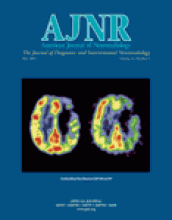Abstract
BACKGROUND AND PURPOSE: Periodically rotated overlapping parallel lines with enhanced reconstruction (PROPELLER or PROP) is an effective means of compensating for head motion during MR imaging in adults. The aim of this study was to assess the value of this novel technique in unsedated children.
METHODS: PROP T2-weighted fast spin-echo (FSE) imaging (TR/TE/NEX, 4000/83/2; 50 seconds) and T2-weighted single-shot FSE (SS-FSE) imaging (19,929/92/0.5; imaging time, 25 seconds) were performed in 35 unsedated children (mean age, 4.7 years ± 4.2) who were undergoing brain MR imaging. Two observers assessed unlabelled images for motion artifact, other artifacts, visibility of pathology, and the preferred image overall. Sequences were compared by using the χ2 test and concordant data from both observers.
RESULTS: Both PROP and the SS-FSE imaging offered equal degrees of motion correction. Metallic artifacts were worse on PROP imaging, likely because of a higher receiver bandwidth (P < .001, χ2 test). Pathology was present in 28 subjects and equally well seen on PROP and SS-FSE images. Overall, PROP was preferred, largely because of its improvements in image contrast (P < .001, χ2 test).
CONCLUSION: SS-FSE imaging and PROP provide equal motion correction, although PROP enables better assessment of the brain parenchyma.
- Copyright © American Society of Neuroradiology












